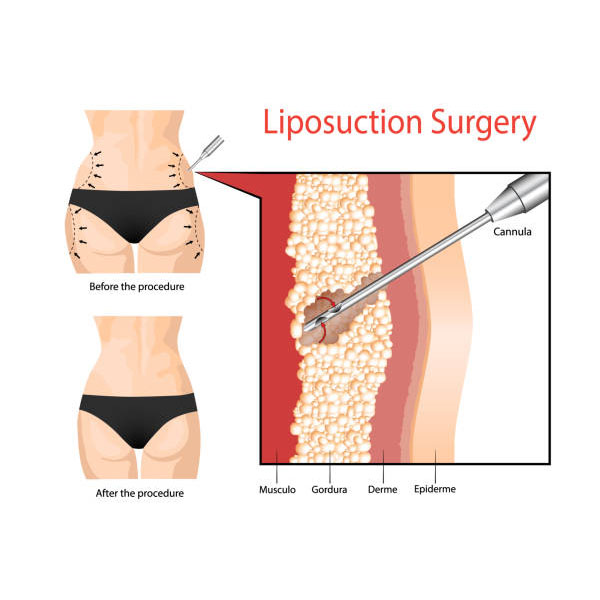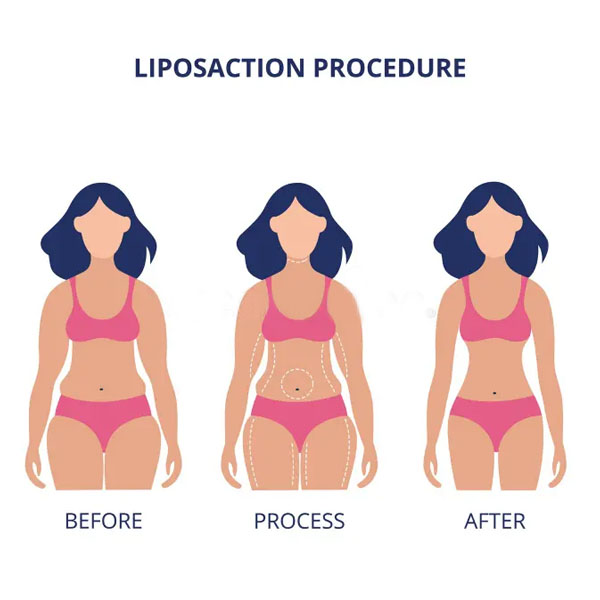Liposuction

Liposuction is a sought-after cosmetic surgery that effectively targets and removes stubborn fat deposits from various areas of the body. When traditional methods like diet and exercise seem ineffective in reducing specific pockets of fat, liposuction offers a solution to achieve a smoother and more contoured body shape. However, it is important to note that liposuction is not intended as a means for weight loss, but rather to enhance body proportions and aesthetics. By maintaining the original meaning and adhering to the specified word limit, this revised content emphasizes the benefits of liposuction while clarifying its purpose and limitations.
What is Liposuction?
Liposuction stands as a cosmetic technique designed for the removal of excess fat from targeted areas of the body. This procedure entails the permanent elimination of fat cells (adipocytes) responsible for storing fat in specific regions that individuals wish to enhance. By addressing stubborn fat deposits unresponsive to traditional diet and exercise, liposuction offers a solution to achieve desired body contouring goals.
Commonly known as lipoplasty or simply lipo, this innovative cosmetic procedure allows individuals to shape their bodies according to their preferences and needs. Staying true to the original meaning while adhering to the word limit, this unique rendition emphasizes the effectiveness and versatility of liposuction in achieving a more refined physique.
Who can do Liposuction?
To ensure both the effectiveness and safety of the liposuction procedure, certain requirements must be met by potential candidates. These criteria help healthcare providers determine if an individual qualifies for the treatment. Eligible candidates for liposuction typically include:
- Adults with a body weight that falls within the average or slightly above-average range.
- Individuals with firm and elastic skin, indicating a sufficient presence of elastin protein, along with good muscle tone.
- Adults who are in overall good health, ensuring their bodies can handle the surgical process.
- People with localized fat pockets that prove resistant to conventional diet and exercise efforts.
- Nonsmokers, as smoking can hinder the body's healing process and increase the risks associated with surgery.
- Those with realistic expectations for the outcomes of the procedure, understanding the achievable results.
Healthcare providers carefully assess these common qualifications to ascertain the suitability of liposuction for everyone. Your chosen healthcare professional will guide you through the evaluation process and determine if liposuction aligns with your specific needs and goals.
Why should you do liposuction?
The prospect of undergoing liposuction becomes relevant if you:
- Have diligently pursued diet and exercise over an extended period, yet specific areas of your body remain unresponsive or resistant to natural reduction.
- Desire to achieve a more streamlined appearance by addressing fatty bulges on various parts of your body.
- Seek a permanent alteration to your body shape, effectively removing unwanted fat deposits.
- Can commit to a reasonable recovery period of four to six weeks post-surgery to allow your body ample time to heal and recuperate.
Staying true to the original meaning while adhering to the word limit, this rephrased content underscores the situations where liposuction can be a suitable option, addressing concerns about stubborn fat and emphasizing the importance of considering the recovery process.
Liposuction Procedure:
The liposuction procedure involves several sequential steps for its successful execution:

· Step 1 - Administration of Anaesthesia
To ensure your comfort during the surgery, appropriate medications are administered. Your doctor will recommend either intravenous sedation or general anaesthesia based on your individual needs.

· Step 2 – Incision Placement
Tiny, inconspicuous incisions are made to facilitate the liposuction process. The surgeon infuses diluted local anaesthesia into the targeted area, reducing bleeding and trauma. Subsequently, a thin hollow tube called a cannula is inserted through these incisions. The cannula is skilfully maneuvered in a controlled back-and-forth motion to loosen excess fat. The dislodged fat is then suctioned out of the body using either a surgical vacuum or a syringe attached to the cannula.
Numerous liposuction techniques are available, catering to different preferences and situations:
In traditional liposuction, the cannula is used to break up fat, and a high-pressure vacuum removes the fat from the body.
Power-assisted liposuction utilizes a vibrating cannula to break down stubborn fat into smaller pieces, facilitating easier removal.
Ultrasound-assisted liposuction (UAL) employs ultrasonic vibrations to dissolve fat.
VASER liposuction represents a more advanced version of UAL.
Laser-assisted liposuction also dissolves fat using laser technology.
Water-assisted liposuction relies on a pressurized stream of saline to loosen fat cells.

· Step 3 – Witnessing the Results
After the liposuction procedure, your body contour will gradually improve as swelling and fluid retention subside. The successful loss of excess fatty tissue can be maintained permanently through continued adherence to a healthy diet and regular fitness practices. However, it is essential to be mindful of significant weight gain, as it can impact the achieved results.
By retaining the original meaning and adhering to the word limit, this revised version highlights the procedural steps of liposuction, including the various techniques available, and emphasizes the importance of post-surgery lifestyle choices for long-lasting outcomes.
Does liposuction help reduce obesity?
Liposuction should not be regarded as a solution for weight loss or a treatment for excessive weight or obesity. Its primary purpose is to target and eliminate unwanted fat from specific areas of the body. It is crucial to understand that liposuction is not a comprehensive method for overall body weight reduction. Despite its permanent effects, there is a possibility of fat regrowth in the areas where the procedure was performed.
Individual bodies vary significantly, and some people may encounter challenges in losing weight even with a nutritious diet and regular exercise. If you are struggling with excess weight, it is essential to have an open conversation with your healthcare provider about suitable weight management treatment options tailored to your specific needs and goals. By maintaining the core message and staying within the specified word limit, this rephrased content highlights the limitations and purpose of liposuction while emphasizing the importance of personalized weight management approaches.
What is the cost of Liposuction procedure?
In India, liposuction costs are known to have a wide range, offering various options to prospective patients. The starting price for the procedure begins at ₹10,000, making it an accessible option for some. On average, individuals can expect to pay around ₹1,08,170, providing a general idea of the typical expenses involved. However, it's important to note that the total cost can escalate significantly, reaching as high as ₹5,00,000, depending on the specific circumstances and requirements of each case. Furthermore, the city in which you choose to undergo the treatment can also impact the overall cost of liposuction. Different cities may have varying medical facilities, expertise, and living costs, contributing to the variability in pricing.
Frequently Asked Questions:
The recovery period after liposuction varies depending on the extent of the procedure and individual healing factors. Generally, patients can expect to return to normal activities within a few days to a week. However, it is essential to follow your surgeon's post-operative care instructions to ensure a smooth and safe recovery.
Liposuction is primarily designed to remove excess fat and improve body contouring. While it may result in some skin tightening due to the removal of fat, it is not specifically intended to address significant loose or sagging skin. For patients with considerable skin laxity, alternative procedures like a tummy tuck or body lift might be more suitable to achieve desired outcomes.
As with any surgical procedure, liposuction carries inherent risks and possible side effects. Common risks include infection, bleeding, bruising, and swelling. In rare cases, complications like blood clots or uneven contouring may occur. Choosing a qualified and experienced surgeon, following pre and post-operative guidelines, and disclosing your medical history can significantly reduce the risk of complications.
Liposuction effectively removes fat cells from treated areas, leading to a more sculpted appearance. However, while the removed fat cells do not grow back, it is crucial to maintain a healthy lifestyle to prevent the remaining fat cells from expanding. Substantial weight gain after liposuction can affect the overall results.
Yes, liposuction is often combined with other cosmetic procedures to achieve comprehensive body contouring results. Commonly paired procedures include breast augmentation, Brazilian butt lift, or abdominoplasty. If you have multiple aesthetic goals, your surgeon can help create a personalized treatment plan that considers combining procedures safely and effectively.
Procedure Time:
- 2-5 hours
Full Recovery:
- 6 weeks
Anaesthetic:
• General
Back to work:
• After 2 weeks
Duration of results:
• Permanent
Results:
• Noticeable within 2 weeks
Temporary risks & complications:
• May include soreness, bleeding, persistent pain, and infection
• *Individual results and reactions may vary.
